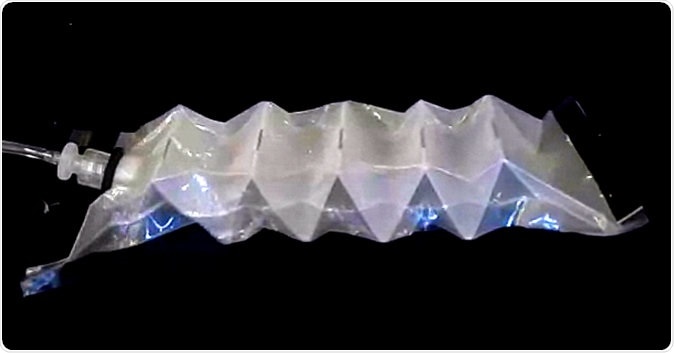Soft robots that are incredibly light and foldable and can lift weights that are over 1,000 times their own weight and these are also cheap and easy to make costing less than a dollar in making charges.

Fluid-driven origami-inspired artificial muscles
Now a team of researchers from MIT Computer Science and Artificial Intelligence Laboratory and Harvard’s Wyss Institute have come up with a “muscle” that weighs only 2.6 grams and can lift weights up to 3 kilograms. It could be likened to a newborn baby lifting a land rover! A traditional robotic arm such as a UR10, on the other hand weighs around 64 pounds and can lift only around one third of its own weight.
Researchers have been working on soft materials for making robots for a while now. However the softer materials when used tend to be less resistant compared to the harder and more inflexible ones. The researchers wanted to use light weight materials compared to the inflexible metallic parts. So they tried a range of materials such as packing foam, springs, plastic sheets etc. These soft materials make the robots safe for human use and interaction during industrial use says the team.
The team says that the soft parts of the robot are inspired by origami – an ancient art of paper folding from Japan. There are multiple chambers in every part of the folds that contain air or water. Between two parts of the robot there is application of vacuum when the fluid gets sucked out. This leads to muscle contraction and drives the motion of the robotic muscle.
Daniela Rus, a roboticist from MIT CSAIL says that it is amazing how these soft and light weight robots can lift so much weight. She adds that these robots could have a future not only in the industrial settings but also at home and in everyday living. To increase its weight lifting abilities the skeleton was made into an accordion like foldable structure she explained. This allowed full rotational and twisting motions to the skeleton. This makes the robot incredibly flexible and internally quite strong. Silicone could be used to make the soft robot resistant to heat and dissolvable materials could be used to make a disposable robot in water. Rus explained that the robots are very much like an elephant trunk – soft, flexible and strong with its “sophisticated manipulation mechanism”. She added that they could be like the human hand that can hold any object firmly while being soft.
Robert Wood who led the research said that humans are “soft and brittle” when compared to robots used in the industry that are used on an assembly line. These industrial robots stop automatically when they come in contact with humans. These robots may allow more human interaction without posing a danger he said. The team hopes to make these robots a reality soon. At present the problem with these soft robots is the inability to reprogramme them or control them unlike traditional robots.
The work explaining the mechanism of creating and using these soft robots was published in the latest issue of the journal PNAS.